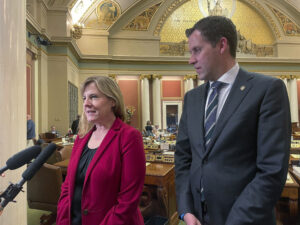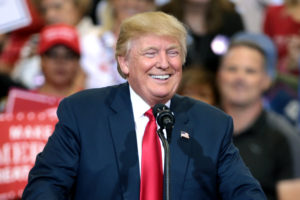A Tale of Two Campaigns
So how did the contest for the Democratic presidential nomination come down to a choice between Barack Obama and Hillary Clinton? We have become so accustomed to their pounding each other relentlessly that we've forgotten that this is a remarkable endgame.WASHINGTON — So how did the contest for the Democratic presidential nomination come down to a choice between Barack Obama and Hillary Clinton? We have become so accustomed to their pounding each other relentlessly that we’ve forgotten that this is a remarkable endgame.
To be sure, just about everyone anticipated that when the field narrowed, Clinton would be one of the contenders left standing. She had won allies from her work for her husband and in the Senate, was helped by the residual affection for Bill Clinton in many parts of the party, and created a support base among women.
But the scenario-builders pondering this contest two years ago imagined a showdown between Clinton and — let’s be honest about it — a white guy. It was thought that a moderate Democrat (popular choices included Mark Warner of Virginia and Evan Bayh of Indiana) would cast himself as the “electable” alternative to the “divisive” Clinton.
Alternatively, John Edwards had the chance to go at Clinton from her left (he’d run against “Clintonomics” as the pro-labor, mill-town-born populist) and from her right (he was, after all, a Southern white male).
Obama upended all these calculations. Warner and Bayh understood how much the race had changed and decided not to run. Obama bested Edwards in Iowa, effectively blocking Edwards’ only path to contention.
Against anyone else but Obama, Clinton could have counted on strong support from African-Americans. Against an Adlai Stevenson-Gary Hart-Paul Tsongas-Bill Bradley sort of reformer, she would have assembled the “regular” Democratic coalition: blue-collar whites allied with black voters. This, more or less, is how Walter Mondale, Bill Clinton and Al Gore all prevailed in the primaries. Against a centrist, Clinton would have won the liberals. Her strength among women would have provided her with additional ballast.
Obama not only created an alliance between African-Americans and upscale reform voters, he also changed the composition of the Democratic electorate by drawing in hundreds of thousands of voters under the age of 30. If Obama prevails, historians will see him as the first Democrat since Franklin Roosevelt to bring a whole new constituency into the system. That, the political scientists tell us, is how realignments happen.
Obama changed the dynamic in another way: As my Brookings Institution colleague (and Clinton supporter) William Galston says, Clinton ran the last campaign of the 20th century while Obama ran the first campaign of the 21st century. Galston argues that Clinton ran a first-rate version of the last century’s campaign — her fundraising by past standards was impressive.
But Obama one-upped her by understanding the new possibilities of modern communications. It wasn’t just that he outperformed Clinton by raising so much money online, he also exploited the social networking sites (and built one of his own), and understood the interaction between virtual communities and real communities.
Obama reached out to bloggers without pandering to them. In 2005, the blogosphere went after Sen. Pat Leahy for supporting the nomination of John Roberts as chief justice. Although Obama opposed Roberts, he defended Leahy against criticisms he called “knee-jerk,” “unfair,” and “dogmatic.”
But Obama took an additional step, as Matt Bai reports in his essential book on the new Democratic politics, “The Argument.” Obama offered a long post of his own on Markos Moulitsas’ Daily Kos site declaring that Americans are “suspicious of labels and suspicious of jargon” and that Democrats should stand for “thoughtfulness and openness.”
At a stroke (as it were), Obama did two things at once. He established himself as a unifier capable of, as he likes to say, “disagreeing without being disagreeable.” And he demonstrated his respect for the blogosphere by arguing with its members in their own space.
Because the Clinton campaign failed to anticipate the imperatives of a race against Obama, it is only in the last two weeks that she has managed to move to offense. Her campaign has gone back to its basic argument that, love her or not, Clinton is the experienced fighter who can be trusted to deal with a nasty world and a decaying economy. She’s trying to turn Obama’s newness into inexperience, his eloquence into slickness, and his conciliatory nature into a form of softness. It is no accident that her “red phone” ad about her readiness to be president was created by a veteran of Mondale’s campaign who had made a similar ad against Gary Hart in 1984.
This is not the campaign Clinton hoped to run, but it’s the one approach she has left, and it’s had the effect of forcing Obama to respond to her. You wonder what would have happened if she had adjusted earlier.
E.J. Dionne’s e-mail address is postchat(at)aol.com.
© 2008, Washington Post Writers Group
Your support matters…Independent journalism is under threat and overshadowed by heavily funded mainstream media.
You can help level the playing field. Become a member.
Your tax-deductible contribution keeps us digging beneath the headlines to give you thought-provoking, investigative reporting and analysis that unearths what's really happening- without compromise.
Give today to support our courageous, independent journalists.






You need to be a supporter to comment.
There are currently no responses to this article.
Be the first to respond.